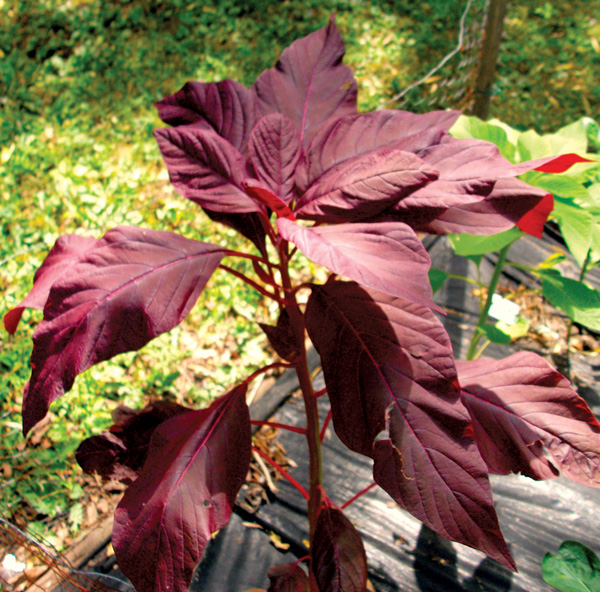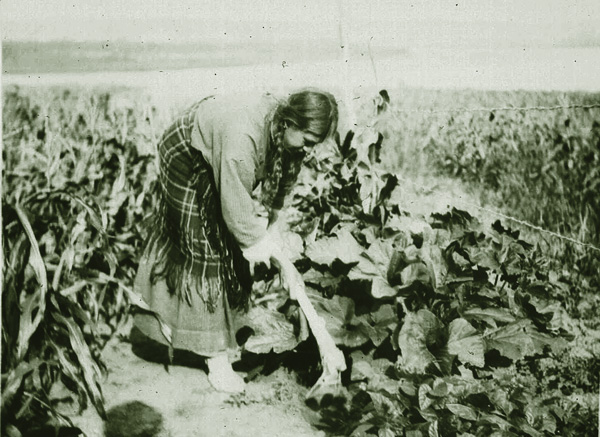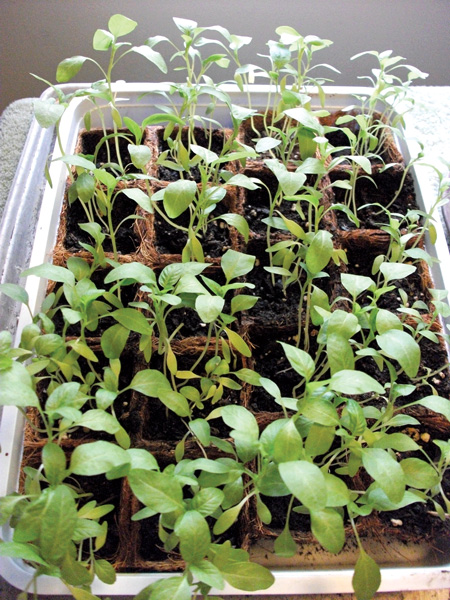The Gift of South Dakota
Subscriptions to South Dakota Magazine make great gifts!
Subscribe today — 1 year (6 issues) is just $29!
Amaranth: The Once and Future Crop?
 |
Could a plant grown as a food crop 1,000 years ago in what is now South Dakota be one of the state’s answers to coming dry seasons? That is the question I arrived at after a yearlong probe into the peculiar properties, mysterious origins and current development of the plant called amaranth.
If you’ve heard the word before but have only a sketchy idea of what it is, you may be surprised to know that it is a product on the market right now, appearing on health food shelves and in mainstream items like bread and cereal. And, it is increasingly popular with gardeners who find it fascinating for its ease of cultivation, colorful appearance and diverse uses in the kitchen.
I embarked on my personal voyage of discovery while writing a book about the Prehistoric Indian Village on the shore of Lake Mitchell, which was inhabited before there was a lake. The book, Village on the Bluff: Prehistoric Farmers/Hunters of the James River Valley, was commissioned by Dr. L. Adrien Hannus, director of the Archeology Laboratory at Augustana College in Sioux Falls. Dr. Hannus told me he wanted an informative layman’s view of the site. Since I was highly qualified as a layman, and not lacking in curiosity or guts, I gladly took the job. Who knew where it would lead?
 |
| The main crops of the Hidatsa and other Native Americans were the "three sisters" of maize, beans and squash. Other crops, including amaranth, were grown as well. Some scholars think amaranth may have antedated all other grains and gave way to them only as the new grains were bred to greater size and bulk. |
The people who inhabited the Mitchell site 1,000 years ago were influenced by the Mississippian culture, which had its center at Cahokia, near what is now St. Louis. The culture included elements carried from further south in the Valley of Mexico. The villagers relied heavily on hunting bison and their vegetable diet, which consisted mostly of crops grown in the valley near the creek, wild berries, roots and other native foodstuffs. Microscopic examination of pollen discovered at the site showed that principal crops were the famous “Three Sisters” originating in Mexico and Central America — maize, beans and squash. But also present were pollen from sunflowers and amaranth.
I was so intrigued by the knowledge that amaranth was cultivated by these ancient peoples that I endeavored to learn more about it. I found enough to write on the subject, but then I decided to grow some. I can report that growing amaranth is not daunting. I was easily able to obtain appropriate seed varieties, two reds and one golden, and in early spring of 2012 I started the plants in peat pots indoors by a sunny window. The plants tend to be frail in the early stages, and I wanted to take no chances with the seeds not reaching maturity. By the time the weather grew warmer, I had enough sturdy plants to make three rows in a 4-foot by 8-foot bed and another row of about 10 feet, with plants left over to stick in odd spots in the garden.
The plants grew vigorously, despite the low-moisture spring and summer. The hot, dry weather was disastrous for my beans, cucumbers and most other vegetables, but the amaranth flourished. By fall, the plants stood 2 to 5 feet tall and the colorful, plume-like heads were heavy with seeds. Harvesting and threshing are often accomplished in one step, usually just after the first frost, by bending the heads into a pail and shaking or beating the plant so that the seeds fall. I wanted to conserve as many seeds as possible, so I snapped off the heads and put them in a plastic bag.
 |
| Amaranth grown for grain does not fare well in containers, so Robinson moved these seedlings to his Sioux Falls garden. |
Threshing was a bit trickier. The seeds are so light that winnowing in the wind, as I have done successfully with wheat, was out of the question; too many seeds would be lost. Various methods have been suggested, but none seem foolproof. I chose to use gloves to rub off the seeds (since the stems and chaff can be prickly and rough on bare fingers) and then collect the seeds and chaff in a bowl. A screen of the proper size can be used to sift out stems and much of the chaff, or by carefully shaking the bowl one can separate the seeds and chaff by weight and gently blow to skim off the chaff. Remaining chaff and stem parts can be removed by hand. If some chaff is left it is not a disaster — while annoying, it is edible.
Of the five plant species discovered at the Mitchell site, amaranth is unique in two respects. First, it is the only one of the group not thought to be exclusively native to the Americas. Second, it is the only one that failed to establish itself as a basic modern-day foodstuff until recently.
The fact that the name amaranthus (meaning “unfading flower”) has Greek roots speaks to the wide distribution of the genus around the world. Some 70 species exist in countries as far away as Australia, but few have been successfully cultivated. Nevertheless, grain amaranth was cultivated in Europe and Asia as well as the Americas in early times and was often associated with religious ceremonies, suggesting that it had a central place as a foodstuff among ancients. Some scholars suggest it may have been the very first grain, supplanted by other grains only as the latecomers attained greater size and volume.
Amaranth was highly prized in Peru and Mexico. It figured among the tribute crops demanded by Aztec ruler Montezuma. With the coming of European conquistadores, however, the growing and consumption of amaranth was nearly terminated. A ban on the plant was made on religious grounds. The Catholic Church found the use of small cakes made of amaranth seed and honey (sometimes allegedly mixed with human blood) in pagan rituals, to be eerily similar to using the host during Mass, and declared it blasphemy. Today, the use of the cakes, often in the shape of skulls but without blood, survives in Mexico, particularly during the weeks leading up to the Day of the Dead. Similar cakes of popped amaranth bound with honey or syrup were eaten in China, Nepal and Argentina.
Among tribes north of the border, amaranth was assigned other uses, as well. In the Southwest, Hopis used a red dye from one species as food coloring and for other coloring purposes.
Given the widespread use of the plant in ancient times, it is curious that amaranth holds such a small niche in today’s market. Other foods from Central and South America have had amazing success. Corn products are virtually ubiquitous, with such ingredients as corn syrup found in a wide selection of products. Beans and squash are also widely consumed. Even the sunflower seed has risen to widespread popularity as a snack. Mention the word amaranth to most people, however, and you will be repaid with blank stares.
How exactly amaranth was used by prehistoric people who populated land along the waterways of the Mississippi drainage is a matter of conjecture. The fact that the seed of the plant is rich in gluten-free protein (better than any other common cereal, and a particularly good source of the amino acid lysine), along with calcium, vitamins and other essential building blocks, may be a clue to its use 1,000 years ago.
Contrary to expectations, according to Dr. Hannus, the people of the Village on the Bluff may not have had a regular supply of fresh meat. The protein in amaranth may have helped fill dietary gaps.
 |
| Robinson found ground amaranth too gritty for pancakes, so he replaced it with cooked amaranth. |
Today amaranth is easily available in supermarket health food sections, in stores devoted to health foods or from web sites. I was fascinated to discover that the seeds could be popped like popcorn, boiled whole for gruel or for soups, ground for inclusion in hot cereals, pancakes, muffins, or other baked goods, sprouted for salads, or made into breakfast flakes. I started including amaranth in my diet. I was particularly proud of my Sunday pancakes, with amaranth, flax, and oat bran added to ease the guilt of a tasty weekly treat.
The young and tender leaves of amaranth plants are edible and are often harvested early in the season and used in salads or cooked as greens. The greens are many times richer in antioxidants than most other salad greens.
What does amaranth taste like? The adjective “nutty” leaps to mind, but I’ve also seen it described as “peppery.” Popped, with a little salt and butter added, it tastes very much like miniature popcorn. Puffed, mixed with heated honey, it will remind you of Rice Krispy bars. In mixtures with other grains and baked or used as a thickener in soups, it imparts a delicate flavor all its own.
If there are commercial growers of amaranth in South Dakota, they are doing a good job of keeping it a secret. Organic farmers, plant specialists and packagers I contacted could not recall anyone in the state raising the crop. When asked why, they came up with reasons ranging from “once bit, twice shy,” through “alcohol addiction,” to “a black sheep in the family.”
Paul O. Johnson, South Dakota State University extension agronomy field specialist based in Watertown, cites the Jerusalem artichoke fiasco as a possible reason that growers in this state are wary of “novelty crops” like amaranth. Many farmers were stung in the early 1980s when a firm called American Energy Farming Systems (AEFS) touted Jerusalem artichokes as a drought-resistant, high-return crop with unbelievable potential for development. Of course, what seems unbelievable often should not be believed. Some growers paid exorbitant prices for seed plants (often over $1,000 per acre sown), and found themselves at harvest time with little or no market for their crop. AEFS soon went bankrupt. Farmers with a long memory can hardly be blamed for being suspicious of get-rich talk about a crop with a funny name.
Like other plants grown in the Prehistoric Village, amaranth now seems to be here to stay, and it offers opportunities for enterprising growers. Its novelty, the combination of its value as an ornamental and as a fun and nutritious food, and the ease of its cultivation and harvesting, make it a welcome addition to the growing beds of those who love gardening.
Five Sisters Stew
For the fun of it, I created this stew mostly using ingredients that might have been found at the Prehistoric Village, particularly those foodstuffs common to the Mississippian culture. You could add a cup of whole corn if you wanted to make that ingredient seem less of an afterthought. By the way, say what you will, both amaranth and refried beans make excellent thickeners. I think you will find this dish to be rich, creamy and satisfying.
 |
1/4 cup chopped sweet onion
1/2 cup chopped celery
2 tablespoons butter or vegetable oil
1/2 cup cooked amaranth
1 1/2 cups cooked butternut squash
1 cup refried beans (about 7 ounces or half a can)
1 can diced tomatoes
1/2 cup vegetable broth
1/2 tsp. cumin
1/2 tsp. salt (or to taste)
1 tbsp. Cholula hot sauce
A sprig of cilantro, tortilla chips, and sunflower seeds to garnish.
Heat butter or oil in a two-quart saucepan over medium heat. Add onion and celery and sauté until onion is clear and soft. Add amaranth, squash, and refried beans and stir thoroughly. Add tomatoes and cook. Flavor with cumin, salt, and hot sauce. Add broth to bring to desired consistency. Garnish with cilantro, chips, and sunflower seeds.
Makes about four servings.
Editor’s Note: This story is revised from the March/April 2013 issue of South Dakota Magazine. To order a copy or to subscribe, call (800) 456-5117.










Comments